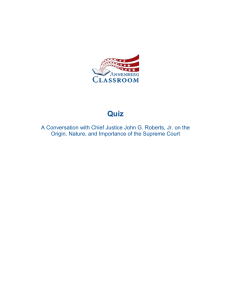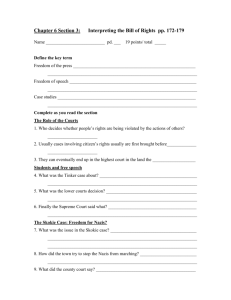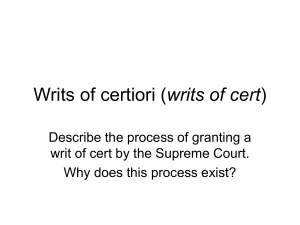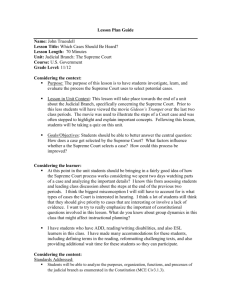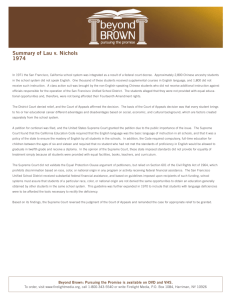Strategies for Obtaining Discretionary Review
advertisement
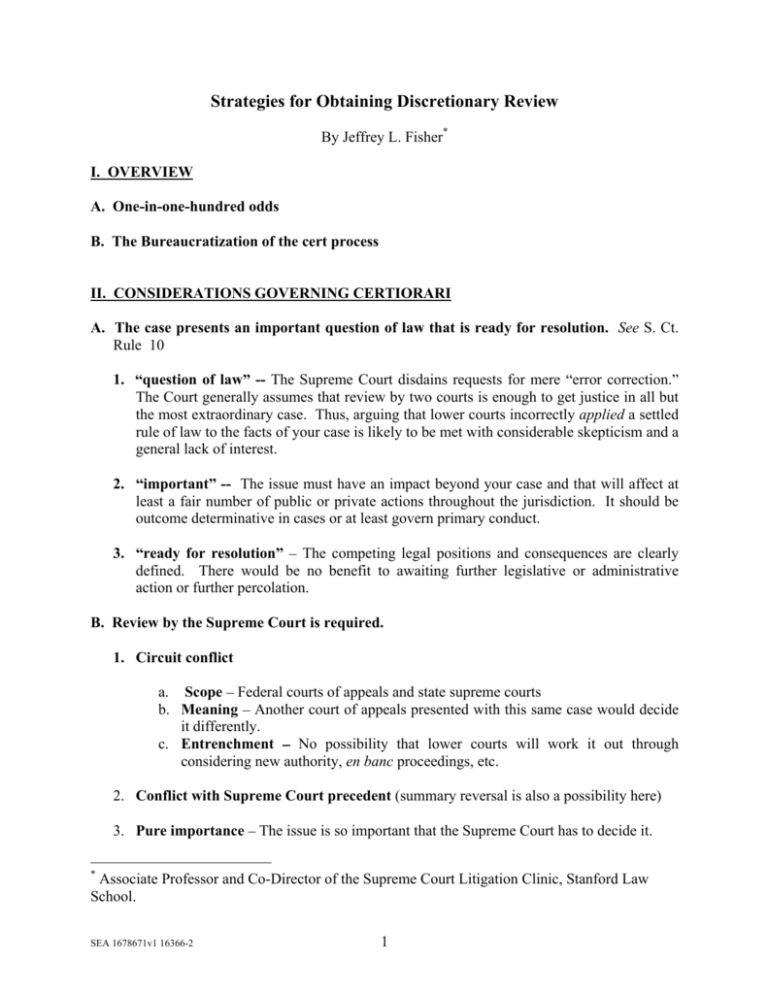
Strategies for Obtaining Discretionary Review By Jeffrey L. Fisher* I. OVERVIEW A. One-in-one-hundred odds B. The Bureaucratization of the cert process II. CONSIDERATIONS GOVERNING CERTIORARI A. The case presents an important question of law that is ready for resolution. See S. Ct. Rule 10 1. question of law -- The Supreme Court disdains requests for mere error correction. The Court generally assumes that review by two courts is enough to get justice in all but the most extraordinary case. Thus, arguing that lower courts incorrectly applied a settled rule of law to the facts of your case is likely to be met with considerable skepticism and a general lack of interest. 2. important -- The issue must have an impact beyond your case and that will affect at least a fair number of public or private actions throughout the jurisdiction. It should be outcome determinative in cases or at least govern primary conduct. 3. ready for resolution The competing legal positions and consequences are clearly defined. There would be no benefit to awaiting further legislative or administrative action or further percolation. B. Review by the Supreme Court is required. 1. Circuit conflict a. Scope Federal courts of appeals and state supreme courts b. Meaning Another court of appeals presented with this same case would decide it differently. c. Entrenchment No possibility that lower courts will work it out through considering new authority, en banc proceedings, etc. 2. Conflict with Supreme Court precedent (summary reversal is also a possibility here) 3. Pure importance The issue is so important that the Supreme Court has to decide it. * Associate Professor and Co-Director of the Supreme Court Litigation Clinic, Stanford Law School. SEA 1678671v1 16366-2 1 4. Invalidation of federal statute C. This case is a good vehicle. 1. Preserved The issue was raised and/or resolved below. 2. Uncluttered The issue is cleanly presented in its customary form. 3. Outcome determinative Resolving the issue will determine who wins the case. 4. Finality The judgment is final, or at least no further proceedings will shed light on the question. 5. Record The case has a well-developed record and no significant factual disputes. D. The decision below is wrong on the merits. III. STRATEGIES A. Petitioner Strategies 1. Draft clean and clear questions presented Try as much as possible to abstract your question presented from the specific facts of your case. Generalize it to a level that shows its importance. The clearer your question presented appears, the better off you are. 2. Don t try (yet) to win on the merits If at all possible, frame your case so that it involves open issue and a split of authority (research here is key), and pluck key reasoning out of conflicting opinions to show the divergence on the meaning of a statute or Supreme Court case. Pushing too hard on the merits to show your side is right may alienate your enemies at the cert stage and cause to lose their cert votes. 3. Use the vehicle section to frame the case Play down any unusual aspects of your case. If they cannot be ignored, try to turn them into strengths by showing just how they highlight the importance of the issue presented. And be cognizant of whether you will get to file a reply brief; often vehicle issues can and should be ignored until then, lest you torpedo your own case on a ground that the other side may not raise. 4. Be scrupulously honest Because the Supreme Court has limited resources to expend on a select group of cases, it is extremely wary of taking a case that may go sideways once review is granted. Accordingly, as a petitioner, you need to assure the Justices that the case is exactly what you say it is. They need to feel confident that your case will not morph into something different once review is granted. SEA 1678671v1 16366-2 2 5. When in doubt, keep it short and simple The best cert petitions are often quite short. It often doesn t take long to describe a split on an important issue. Once again, security that the Justices know what they re getting helps your cause. B. Respondent Strategies 1. Present the case as dull, factbound, complicated, and quirky. 2. Even if there is a split in the lower courts, the conflict is not worthy of review a. b. c. d. The split is illusory because both sides end up in the same place. The split goes away once a new Supreme Court decision is considered. The split may go away on its own if further percolation is allowed. Legislative or regulatory action may resolve the split. 3. Point out as many vehicle problems as possible A vehicle problem is any reason why the Court could resolve the case without resolving the question presented. Examples include: a. b. c. d. The facts of case don t squarely present the issue. Facts of case are unusual, so Court might not need to resolve split. The decision below can be affirmed on alternate grounds. Any error regarding the question presented is harmless. 4. Other reasons why the question presented is not important a. b. c. The split is stale; it hardly ever comes up. The issue is rarely outcome-determinative in cases. Uniformity on the issue is not critical. 5. Argue that the decision below is correct. Finally, one can argue that that even if there is a split on an important issue, the Court should conserve its resources to reverse erroneous judgments, and the decision below is correct. This strategy works especially well when one renegade court has created a split with a poorly reasoned decision. Tell the Court it should wait for a decision from the renegade court before expending resources on the issue. SEA 1678671v1 16366-2 3





